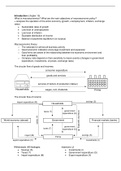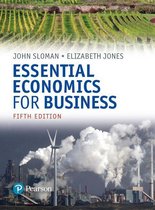Introduction (chapter 15)
What is macroeconomics? What are the main objectives of macroeconomic policy?
= analyses the operation of the entire economy (growth, unemployment, inflation, exchange
rates)
• Sustainable rates of growth
• Low level of unemployment
• Low level of inflation
• Equitable distribution of income
• Balance of payments equilibrium (or surplus)
Macroeconomic theory:
o The rationale for almost all business activity
o Good economic indicators encourage investment and expansion
o Good firms are aware of the relationship between the economic environment and
their profitability
o Company risks depend on their sensitivity to macro events (changes in government
expenditure, investments, oil prices, exchange rates)
The circular flow of goods and incomes:
consumer expenditure
goods and services
services of factors of production (labour)
wages, rent, dividends
The circular flow of income:
import expenditure (M) savings (S)
Households
government
consumer spending (E)
taxes (T)
expenditure (G)
salary (Y)
World economy (abroad) Government Financial markets (banks)
government
taxes (T) expenditure (G)
import (M) savings (S)
Firms
export expenditure (X) investments (I)
Withdrawals (W)/leakages: Injections (J)
• Savings (S) • Investments (I)
• Taxes (T) • Government expenditure (G)
• Import expenditure (M) • Export expenditure (X)
,Measuring national income (GDP): E + I + G (X - M)
Households’ disposable income (taking account of inflation, population and purchase power)
Gross domestic product = the monetary value of all finished goods and services made within
a country during a specific period
• The production method: final output - imports
• The income method: labour income + capital income
• The expenditure method: C + I + G + NX
Final output = the value of all produced goods and services
Labour income = the total value of all incomes earned
Capital income = income that is generated by investment (buying land and selling for profit)
GDP deflator = measures the overall level of prices (nominal GDP / real GDP x 100)
o Nominal GDP bruto binnenlands product
o Real GDP: netto binnenlands product (with inflation)
Government expenditure (G) Interest rates (i)
Income (GDP or Y) Import (m)
Investment (I) Export (x)
The circular flow of national income and expenditure: Production
income
expenditure
National income statistics = suitable measures of living standards
• Items that are excluded: non-marketed items, the underground economy
• Production (poor indicator of welfare): human costs of production, externalities,
production of some ‘bads’ may increase GDP, distribution of income
• The use of Index of Sustainable Economic Welfare
Economic systems = methods of classification by degree of government control
• The command economy (features of a command economy are consumption ad
investment, matching of inputs and outputs, distribution of output)
Advantages: high investment and growth, stable growth, social goals pursued, low
unemployment
Problems: problems of gathering information, expensive to administer, inappropriate
incentives, shortages and surpluses
• The free market economy (demand and supply decisions, the interdependence of
markets and the price mechanism of shortages and surpluses, equilibrium price,
response to changes in demand and supply)
Advantages: transmits information between buyers and sellers, no need for costly
bureaucracy, incentives to be effective, competitive markets responsive to consumers
Problems: competition may be limited (problem of market power), inequality, the
environment and other social goals may be ignored
• Mixed economy
, The money supply (chapter 18)
Controlling the money supply (narrow money, broad money, fiat money with no intrinsic
value) via open market operations
The functions of money: medium of exchange, means of storing wealth, means of evaluation,
and means of establishing value of future claims and payments
The ideal attributes of money:
o Durability
o Divisibility
o Transportability
o Non-counterfietability
The role of the central bank:
• Note issue
• Lender of last resort to commercial banks
• Provider of liquidity to banks
• Oversees the activities of banks and other financial institutions
• Manages the government’s borrowing programme
• Operates monetary policy
• Controls inflation
• Operates exchange rate policy and manages reserves
The Eurozone money supply:
M1) cash in circulation + overnight deposits
M2) M1 + bank bonds maturing in up to 2 years + deposits requiring up to 3 months’ notice
M3) M2 + company bonds maturing in up to 2 years
Eurozone monetary aggregates:
o M1: a narrow monetary aggregate that comprises currently in circulation plus
overnight deposits held with MFIs and central government
o M2: an intermediate monetary aggregate that comprises M1 plus deposits
redeemable at a period of notice of up to and including three months (short-term
savings deposits) and deposits with an agreed maturity of up to and including two
years (short-term time deposits) held with MFIs and central government
o M3: a broad monetary agreement that compromises M2 plus marketable instruments,
in particular repurchase agreements, money market fund shares and units, and debt
securities with a maturity of up to and including two years issued by MFIs
Government bonds:
• Governments (G) raise money from taxes and the sale of government bonds
• When the government want to inject money into the economy, they buy bonds, this
lowers interest rates
• When the government want to reduce the amount of money in the economy, they sell
bonds, this raises interest rates





